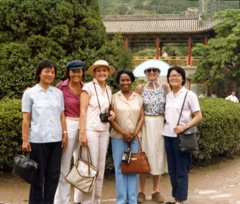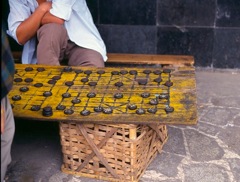| press the forward arrow for Chinese music |
photos from the Science Education Delegation to China,
June 23 to July 15, 1979
In 1979 a group of science educators from the USA was invited to visit Beijing, Shanghai, and Xi'an in exchange for a similar group of science educators from China.
Arthur Luehrmann was part of that group and took most of the following pictures.

197907Group
Jim Rutherford, the co-leader of the group, is in checked shirt, mustache, towards rear. Just behind him and to the right is Paul Hurd, the other co-leader The chief interpreter (Zhiang?) is the woman on the far right in about the middle row. At her left, in a hat, is Bart Bartholomew. Arthur Luehrmann is the 3rd from the left in the rear row. To his right is the director of the Franklin Institute. The black woman to the left of Arthur (and a bit in front) is Alice _, a teacher at the lab school at the Univ. of Chicago. To the right of Arthur, and in the next row in front, is Mary Budd Rowe, science education researcher at the University of Florida

197906SmlGrp1
local translator, Alice _, _, _, Mary Budd Rowe, Zhiang (chief translator)

197906Headdress
headdress

197906SciCabinet
Science lab equipment of Normal School #12 of Peking Normal University

197906PingPong
blackboard and ping-pong

197906BlkBd
blackboard at Peking Normal University?

197906Class
classroom at Peking Normal University?

197906TurtleStatue
turtle statue at the Imperial Palace, Forbidden City, Beijing, China

197906EmpBath
Jim Rutherford in the Emperor's Bath, Xian, China

197906Dragon
dragon at the Forbidden City, Beijing, China

197906Urn
urn in the Forbidden City, Beijing, China

197906Park
Forbidden City, Beijing, China

197906Banquet
banquet

197906Statues
Xian, China figures (but not at the archeological dig)

197906MaleStatue
figure of a man, Xian, China (but not from the archeological dig)

197906Throne
Throne room, Forbidden City, Beijing, China.
The dowager empress would stand behind the screen at the rear of the throne and whisper directions to the young emperor.

197906WallDetail
As in Western chess, there are 16 pieces with different rank and capabilities. Instead of a king, there’s a “general”. The “general” can not only be captured like in normal chess, but actually taken (like in some fast chess variations).
This game is very popular. Here you can see an unused board, the two players on the left are actually playing on the next board.

wu10
Chinese chess